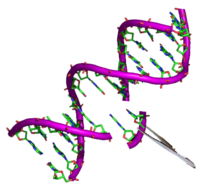
Photo from wikipedia
The ruminant-associated influenza D virus (IDV) has a broad host tropism and was shown to have zoonotic potential. To identify and characterize molecular viral determinants influencing the host spectrum of… Click to show full abstract
The ruminant-associated influenza D virus (IDV) has a broad host tropism and was shown to have zoonotic potential. To identify and characterize molecular viral determinants influencing the host spectrum of IDV, a reverse genetic system is required. For this, we first performed 5′ and 3′ rapid amplification of cDNA ends (RACE) of all seven genomic segments, followed by assessment of the 5′ and 3′ NCR activity prior to constructing the viral genomic segments of a contemporary Swiss bovine IDV isolate (D/CN286) into the bidirectional pHW2000 vector. The bidirectional plasmids were transfected in HRT-18G cells followed by viral rescue on the same cell type. Analysis of the segment specific 5′ and 3′ non-coding regions (NCR) highlighted that the terminal 3′ end of all segments harbours an uracil instead of a cytosine nucleotide, similar to other influenza viruses. Subsequent analysis on the functionality of the 5′ and 3′ NCR in a minireplicon assay revealed that these sequences were functional and that the variable sequence length of the 5′ and 3′ NCR influences reporter gene expression. Thereafter, we evaluated the replication efficiency of the reverse genetic clone on conventional cell lines of human, swine and bovine origin, as well as by using an in vitro model recapitulating the natural replication site of IDV in bovine and swine. This revealed that the reverse genetic clone D/CN286 replicates efficiently in all cell culture models. Combined, these results demonstrate the successful establishment of a reverse genetic system from a contemporary bovine IDV isolate that can be used for future identification and characterization of viral determinants influencing the broad host tropism of IDV.
Journal Title: Viruses
Year Published: 2021
Link to full text (if available)
Share on Social Media: Sign Up to like & get
recommendations!